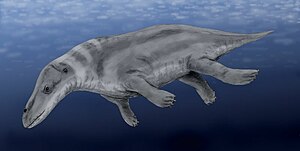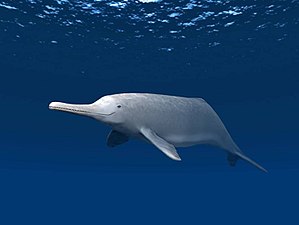|
تضامنًا مع حق الشعب الفلسطيني |
قائمة الحيتانيات المنقرضة
تتضمن قائمة الحيتانيات المنقرضة على الأجناس والأنواع المُنقرضة من رتبة الحيتانيات. الحيتانيات (الحيتان والدلافين وخنازير البحر) هي من نسل الثدييات التي تعيش على الأرض، وذوات الحوافر الزوجية. كانت الحيتانيات الأولى لا تزال ثدييات ذات حوافر. أصبحت هذه الحيتانيات المبكرة تتكيف تدريجيًا مع السباحة بشكلٍ أفضل من المشي على الأرض، وتطورت أخيرًا إلى حيتانيات بحرية كاملة.
تتضمن هذه القائمة حاليًا الأجناس والأنواع الأحفورية فقط. ومع ذلك، انقرضت مجموعة الحيتان الرمادية في المحيط الأطلسي (الاسم العلمي: Eschrichtius robustus) في القرن الثامن عشر، وأُعلن أن بايجي (أو دلفين النهر الصيني (الاسم العلمي: Lipotes vexillifer)) قد انقرض عمليًا [English] بعد فشل رحلة استكشافية في أواخر عام 2006 في العثور على أي منها في نهر يانغتسي.
رتيبة الحيتان القديمة
فصيلة الحيتان الجوالة
(فترة الإيوسين)

فصيلة العظاءات الملكية
(مرحلة الإيوسين المتأخر)

فصيلة الكيكندونات
(فترة الأوليغوسين)
فصيلة الحيتان الباكستانية
(من مرحلة الإيوسين المبكر إلى المتوسط)

فصيلة الحيتان الأولية
(فترة الإيوسين)

فصيلة الحيتان الرمنغتونية
(فترة الإيوسين)
رتيبة الحيتان البالينية
فصيلة Aetiocetidae
(فترة الأوليغوسين)

فصيلة Llanocetidae
(Late Eocene-Early Oligocene)
فصيلة Mammalodontidae
(jr synonym Janjucetidae)

(Late Oligocene)
فصيلة أصنوفة غير محددة
أصنوفة Chaeomysticeti
فصيلة أصنوفة غير محددة
فوق فصيلة قريبات الحيتان البالينية الفجرية
فصيلة Cetotheriopsidae
(الأوليغوسين إلى الميوسين)
فصيلة الحيتان البالينية الفجرية
(الأوليغوسين إلى الميوسين المبكر)
فصيلة Aglaocetidae
(فترة الميوسين)
فوق فصيلة البالينات وأشباهها
فصيلة البالينات
(من فترة الأوليغوسين إلى زمن قريب)
فصيلة أصنوفة غير محددة
أصنوفة Thalassotherii
فصيلة حوتيات وحشية
(فترة الميوسين-فترة البليوسين)
Classification follows Steeman, 2007.[8]

- Brandtocetus
- Cephalotropis
- سيتوثيريوم
- Eucetotherium
- Herentalia
- Herpetocetus
- Hibacetus[9]
- Joumocetus[10]
- Kurdalagonus
- Metopocetus
- Mithridatocetus
- Nannocetus

Parietobalaena palmeri skull - Otradnocetus
- Piscobalaena[11]
- Titanocetus[12]
- Tiucetus
- Vampalus
- Zygiocetus[13]
فصيلة Diorocetidae
(فترة الميوسين إلى فترة البليوسين)
فصيلة Neobalaenidae
(فترة الميوسين إلى زمن قريب)
فصيلة Pelocetidae
(فترة الميوسين)
فصيلة أصنوفة غير محددة
فوق فصيلة هراكلة

فصيلة هراكلة
(فترة الميوسين إلى زمن قريب)
- Archaebalaenoptera
- هركول (extant)
- "Balaenoptera" cortesii
- "Balaenoptera" portisi
- "Balaenoptera" ryani
- Burtinopsis
- Cetotheriophanes
- Fragilicetus[15]
- Incakujira
- Parabalaenoptera
- Plesiobalaenoptera
- Plesiocetus
- Praemegaptera
- Protororqualus
فصيلة الحيتان الرمادية
(فترة الميوسين إلى زمن قريب)
فصيلة Tranatocetidae
فصيلة أصنوفة غير محددة
- Halicetus
- Imerocetus
- Mioceta (تسمية غامضة)
- Piscocetus
- Siphonocetus (تسمية غامضة)
- Tretulias (تسمية غامضة)
- Ulias (تسمية غامضة)
رتيبة الحيتان المسننة
أشكال قاعدية
فصيلة Agorophiidae
(Late Oligocene)
فصيلة Ashleycetidae
(Early Oligocene)
فصيلة Mirocetidae
(Early Oligocene)
فصيلة Patriocetidae
(Oligocene to Early Miocene)
فصيلة Simocetidae
(Late Oligocene)
فصيلة Xenorophidae
(فترة الأوليغوسين)
فصيلة Inticetidae
فوق فصيلة الإسكوالودونات وأشباهها
فصيلة الدلفازينات
(Late Oligocene to Miocene)
فصيلة الإسكوالودونات الأولية
(Oligocene to Miocene)
فصيلة الإسكوالودونات
(Oligocene to Pliocene)
- الإسكوالودون (مرادفات Kelloggia, Rhizoprion, Crenidelphinus, Arionius, Phocodon)
- الإسكوالودون الجنوبي
- الإسكوالودون الفجري
- Macrophoca
- Pachyodon
- Phoberodon
- Smilocamptus
- Tangaroasaurus
فوق فصيلة حيتان العنبر
فصيلة الحيتان القزمة
(فترة الميوسين إلى زمن قريب)
- Aprixokogia
- Kogia (extant)
- Koristocetus
- Nanokogia
- Praekogia
- Scaphokogia
- Thalassocetus
فصيلة حيتان العنبر
- Aulophyseter
- Diaphorocetus
- Ferecetotherium
- Idiophyseter
- Idiorophus
- حوت حفري
- حوت العنبر الصغير
- Placoziphius
- Preaulophyseter
فصيلة أصنوفة غير محددة
- Acrophyseter
- Albicetus
- Brygmophyseter
- دلفين حقيقي
- Helvicetus (تسمية غامضة)
- Hoplocetus (تسمية غامضة)
- Kogiopsis
- لوياثان (حوت)[19]
- Miokogia (تسمية غامضة)
- Paleophoca (تسمية غامضة)
- Placoziphius
- عنبر سالف (تسمية غامضة)
- حوت سخيلده (تسمية غامضة)
- Zygophyseter
فوق فصيلة "Eurhinodelphinoidea"
فصيلة Argyrocetidae
(Late Oligocene to Early Miocene)
فصيلة Eoplatanistidae
(فترة الميوسين)
فصيلة Eurhinodelphinidae
(Mid Miocene to Pliocene)

- Ceterhinops
- Eurhinodelphis
- Iniopsis
- Mycteriacetus
- Phocaenopsis
- Schizodelphis
- Vanbreenia
- Xiphiacetus
- Ziphiodelphis
فوق فصيلة الدلافين النهرية
فصيلة Allodelphinidae
(Early to Middle Miocene)

فصيلة دولفين نهر الغانج
(فترة الميوسين إلى زمن قريب)
فصيلة Squalodelphinidae
(Early to Late Miocene)
فصيلة Waipatiidae
فوق فصيلة حوت منقاري
فصيلة Squaloziphiidae
(Early Miocene)
فصيلة حوت منقاري
(فترة الميوسين إلى زمن قريب)
- Basal forms
- أسرة حوت منقاري
- أسرة حوت منقاري
- Africanacetus
- Ihlengesi
- Khoikhoicetus
- Mesoplodon (extant)
- Nenga
- Pterocetus
- Xhosacetus
- أسرة حوت منقاري
- أسرة أصنوفة غير محددة
أصنوفة Delphinida
فصيلة Kentriodontidae
(Early-Middle Miocene)

فصيلة أصنوفة غير محددة
- Anacharsis
- Belonodelphis
- Delphinavus
- Graamocetus
- Hadrodelphis
- Lamprolithax
- Leptodelphis
- Liolithax
- Lophocetus
- Loxolithax
- Macrokentriodon
- Microphocaena
- Miodelphis
- Nannolithax
- Oedolithax
- Oligodelphis
- Palaeophocaena
- Pithanodelphis
- Platylithax
- Prionodelphis
- Protodelphinus
- Sarmatodelphis
- Sophianacetus
- Tagicetus
فوق فصيلة دلافين
فصيلة Albireonidae
(فترة الميوسين إلى فترة البليوسين)
فصيلة دلفين محيطي

(Oligocene to Recent)
- Arimidelphis
- Astadelphis
- Australodelphis
- Delphinus (extant)
- Eodelphinus
- Etruridelphis
- Hemisyntrachelus
- Lagenorhynchus (extant)
- Orcinus (extant)
- Platalearostrum[25]
- Protoglobicephala
- Pseudorca (extant)
- Septidelphis[26]
- Sinanodelphis
- Stenella (extant)
- Tursiops (extant)
فصيلة الحيتان البيضاء
(فترة الميوسين إلى فترة البليوسين)
فصيلة دلفين شبيه الفظ
(Pliocene)

فصيلة خنزير البحر
(فترة الميوسين إلى زمن قريب)
- Archaeophocaena
- Australithax
- Brabocetus
- Haborophocoena
- Lomacetus
- Miophocaena
- Numataphocoena
- Piscolithax
- Pterophocaena
- Salumiphocaena
- Semirostrum[27]
- Septemtriocetus
فوق فصيلة دلافين نهرية
فصيلة إنيادية
فصيلة دلفين لابلاتا
(Middle Miocene to Recent)
فوق فصيلة بايجي
فصيلة دلافين مهجورة
(فترة الميوسين إلى زمن قريب)
فوق فصيلة أصنوفة غير محددة
فصيلة أصنوفة غير محددة
- Acrodelphis
- Agriocetus
- Atropatenocetus (فترة الأوليغوسين)
- Champsodelphis
- Hesperocetus
- Imerodelphis (فترة الميوسين)
- Kharthlidelphis
- Lonchodelphis
- Macrochirifer
- Microcetus
- Microsqualodon
- Microzeuglodon
- Neosqualodon
- Olympicetus
- Pelodelphis
- Rhabdosteus (تسمية غامضة)
- Saurocetus (فترة الأوليغوسين)
- Sulakocetus
انظر أيضًا
المراجع
- ^ (PDF) https://web.archive.org/web/20120218123052/http://deepblue.lib.umich.edu/bitstream/2027.42/57499/1/Vol%2031%20No%2013%20final%2012-19-07.pdf. مؤرشف من الأصل (PDF) في 2012-02-18.
{{استشهاد ويب}}: الوسيط|title=غير موجود أو فارغ (مساعدة) - ^ Gingerich, P.D. et al. 2001. Origin of Whales from Early Artiodactyls: Hands and Feet of Eocene Protocetidae from Pakistan. (19 September 2001). Science دُوِي:10.1126/science.1063902.
- ^ أ ب Sunil Bajpai and J.G.M. Thewissen (2014). "Protocetid cetaceans (Mammalia) from the Eocene of India". Palaeontologia Electronica 17 (3): Article number 17.3.34A.
- ^ Philip D. Gingerich and Henri Cappetta (2014). "A New Archaeocete and Other Marine Mammals (Cetacea and Sirenia) from Lower Middle Eocene Phosphate Deposits of Togo". Journal of Paleontology. ج. 88 ع. 1: 109–129. DOI:10.1666/13-040.
- ^ Ryan M. Bebej, Iyad S. Zalmout, Ahmed A. Abed El-Aziz, Mohammed Sameh M. Antar and Philip D. Gingerich (2016). "First remingtonocetid archaeocete (Mammalia, Cetacea) from the middle Eocene of Egypt with implications for biogeography and locomotion in early cetacean evolution". Journal of Paleontology. in press. doi:10.1017/jpa.2015.57.
- ^ Felix G. Marx, Cheng-Hsiu Tsai and R. Ewan Fordyce (2015). "A new Early Oligocene toothed ‘baleen’ whale (Mysticeti: Aetiocetidae) from western North America: one of the oldest and the smallest". Royal Society Open Science 2 (12): 150476. doi:10.1098/rsos.150476.
- ^ Jonathan H. Geisler; Robert W. Boessenecker; Mace Brown; Brian L. Beatty (2017). "The Origin of Filter Feeding in Whales". Current Biology. in press. doi:10.1016/j.cub.2017.06.003.
- ^ M. E. Steeman (2007). "Cladistic analysis and a revised classification of fossil and recent mysticetes". Zoological Journal of the Linnean Society. ج. 150 ع. 4: 875–894. DOI:10.1111/j.1096-3642.2007.00313.x.
- ^ Otsuka، H.؛ Ota، Y. (2008). "Cetotheres from the early Middle Miocene Bihoku Group in Shobara District, Hiroshima Prefecture, West Japan". Miscellaneous Reports of the Hiwa Museum for Natural History. ج. 49 ع. 2: 1–66.
- ^ Kimura، T.؛ Hasegawa، Y. (2010). "A new baleen whale (Mysticeti: Cetotheriidae) from the earliest late Miocene of Japan and a reconsideration of the phylogeny of cetotheres". Journal of Vertebrate Paleontology. ج. 30 ع. 2: 577–591. DOI:10.1080/02724631003621912.
- ^ Bouetel، V.؛ Muizon، C. de (2006). "The anatomy and relationships of Piscobalaena nana (Cetacea, Mysticeti), a Cetotheriidae s.s. from the early Pliocene of Peru" (PDF). Geodiversitas. ج. 28 ع. 2: 319–395. مؤرشف من pdf الأصل في 2007-10-30.
{{استشهاد بدورية محكمة}}: تحقق من قيمة|مسار=(مساعدة) - ^ Bisconti، M. (2006). "Titanocetus, a new baleen whale from the middle Miocene of northern Italy (Mammalia, Cetacea, Mysticeti)". Journal of Vertebrate Paleontology. ج. 26 ع. 2: 344–354. DOI:10.1671/0272-4634(2006)26[344:tanbwf]2.0.co;2. JSTOR:4524574.
- ^ K. K. Tarasenko (2014). "Novye rody usatykh kitov (Cetacea, Mammalia) iz miotsena Severnogo Kavkaza i Predkavkaz'ya. 3. Zygiocetus gen. nov. (srednii sarmat, Adygeya)". Paleontological Journal 48 (5).
- ^ Robert W. Boessenecker (2013). "A new marine vertebrate assemblage from the Late Neogene Purisima Formation in Central California, part II: Pinnipeds and Cetaceans". Geodiversitas. ج. 35 ع. 4: 815–940. DOI:10.5252/g2013n4a5. مؤرشف من الأصل في 2019-12-11.
- ^ Bisconti, M. and Bosselaers, M. (2016), Fragilicetus velponi: a new mysticete genus and species and its implications for the origin of Balaenopteridae (Mammalia, Cetacea, Mysticeti). Zoological Journal of the Linnean Society, 177: 450–474. doi: 10.1111/zoj.12370
- ^ Kellogg، R. (1934). "A new cetothere from the Modelo Formation at Los Angeles, California". Carnegie Institution of Washington. ج. 447: 83–104.
- ^ The Origin of High-Frequency Hearing in Whales: Current Biology نسخة محفوظة 31 ديسمبر 2018 على موقع واي باك مشين.
- ^ Fitzgerald, E.M.G. 2004. A review of the Tertiary fossil Cetacea (Mammalia) localities in Australia. Memoirs of Museum Victoria 61(2): 183-208.
- ^ Lambert, O., G. Bianucci, K. Post, C. de Muizon, R. Salas-Gismondi, M. Urbina & J. Reumer. (2010). The giant bite of a new raptorial sperm whale from the Miocene epoch of Peru. Nature 466: 105–108. دُوِي:10.1038/nature09067
- ^ Yoshihiro Tanaka; R. Ewan Fordyce (2016). "Awamokoa tokarahi, a new basal dolphin in the Platanistoidea (late Oligocene, New Zealand)". Journal of Systematic Palaeontology. Online edition. doi:10.1080/14772019.2016.1202339.
- ^ أ ب Kimura, T. and Barnes, L.G., 2016. New Miocene fossil Allodelphinidae(Cetacea, Odontoceti, Platanistoidea) from the North Pacific Ocean. Bulletin of the Gunma Museum of Natural History 20:1-58.
- ^ Olivier Lambert, Giovanni Bianucci, Mario Urbina, 2014. Huaridelphis raimondii, a new early Miocene Squalodelphinidae (Cetacea, Odontoceti) from the Chilcatay Formation, Peru. Journal of Vertebrate Paleontology 34 (5):987-1004.
- ^ Gabriel Aguirre-Fernández and R. Ewan Fordyce (2014). "Papahu taitapu, gen. et sp. nov., an early Miocene stem odontocete (Cetacea) from New Zealand". Journal of Vertebrate Paleontology. ج. 34 ع. 1: 195–210. DOI:10.1080/02724634.2013.799069.
- ^ Lambert, O., and S. Louwye. 2016. A new early Pliocene species of Mesoplodon: a calibration mark for the radiation of this species-rich beaked whale genus. Journal of Vertebrate Paleontology. DOI: 10.1080/02724634.2015.1055754.
- ^ Klaas Post & Erwin J.O. Kompanje (2010). "A new dolphin (Cetacea, Delphinidae) from the Plio-Pleistocene of the North Sea". Deinsea 14: 1–13. ISSN 0923-9308.
- ^ Giovanni Bianucci (2013). "Septidelphis morii, n. gen. et sp., from the Pliocene of Italy: new evidence of the explosive radiation of true dolphins (Odontoceti, Delphinidae)". Journal of Vertebrate Paleontology. ج. 33 ع. 3: 722–740. DOI:10.1080/02724634.2013.744757.
- ^ Rachel A. Racicot, Thomas A. Deméré, Brian L. Beatty, Robert W. Boessenecker. Unique Feeding Morphology in a New Prognathous Extinct Porpoise from the Pliocene of California. Current Biology, 13 March 2014 DOI: 10.1016/j.cub.2014.02.031

